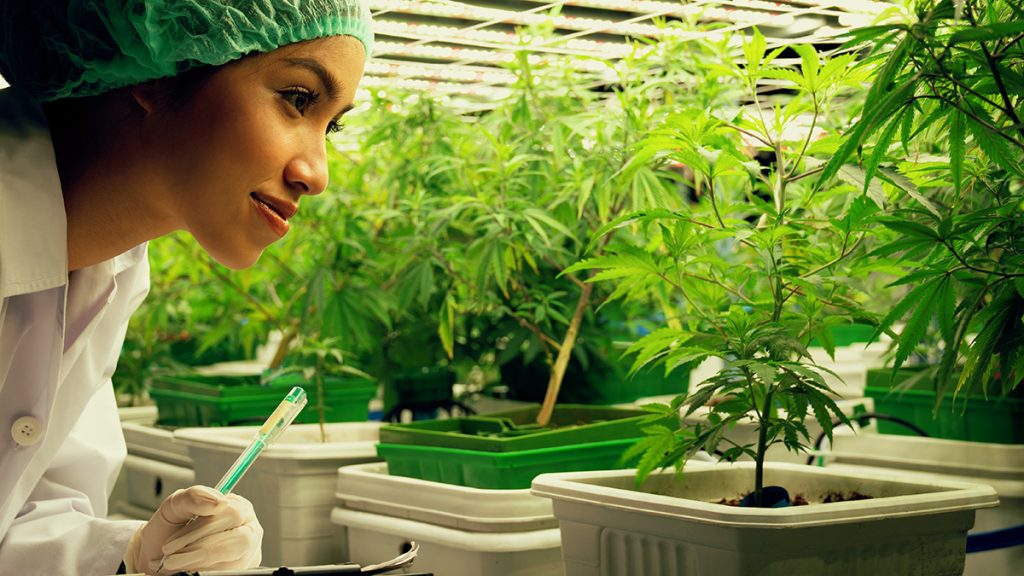
Cannabis reporters use science and some healthy skepticism to cover the beat
Some of the science is flawed or skewed. But there are studies out there to help you explain marijuana’s benefits and risks
Bryan Chou graduated in May with a master’s degree from the Missouri School of Journalism. This article was developed from his master’s research project.
Scientific research is integral to journalism, especially in science and health reporting. But how should journalists adapt if there’s a lack of research available to them?
In a series of interviews, journalists who have covered cannabis agree that the lack of medical research poses a challenge to their reporting, requiring them to interpret limited evidence for the readers. Jeremy Berke, a former cannabis reporter for Business Insider, added that current research on cannabis heavily relies on self-reported data, which makes it less credible than randomized controlled trials.
One of the main obstacles to studying the health effects of cannabis is its classification as a Schedule I substance. To study cannabis, scientists need a research registration with the Drug Enforcement Administration before legally obtaining the plant from a licensed cultivator. And until 2021, the University of Mississippi, in collaboration with the National Institute on Drug Abuse, was the only legal provider of the cannabis plant.
The DEA proposed reclassifying cannabis last year as a less dangerous drug, citing its medical use and lower potential for abuse than drugs like heroin. At his April confirmation hearing, new DEA Administrator Terrance Cole described the rescheduling review as “one of my first priorities,” but stopped short of endorsing the proposal.
Scholars pointed out cannabis research has been skewed from the beginning, focusing mostly on the negative impacts. The reason is that the National Institute on Drug Abuse — the agency that has long controlled the legal supply of cannabis plants — primarily funded research on drug abuse and addiction.
Berke said he might consider keeping track of research abroad like from Canada and elsewhere, where researchers have more freedom to conduct clinical trials to understand the effects of cannabis legalization. But some of the studies were funded by cannabis companies and carried their own risks, he said.
Everything in cannabis seems to be in a “gray area,” said Alex Halperin, who writes WeedWeek, a newsletter covering California’s cannabis industry. For example, research is still mixed on whether cannabis helps with PTSD symptoms. But “in the absence of the ability to do that research, a lot of veterans decided for themselves that it helps,” Halperin said. It doesn’t “constitute scientific proof in a conventional sense, but it’s the only proof available to us.”
For this project, I interviewed eight journalists with experience reporting on cannabis with focuses on business and policy. Given the gap in research, they highlight the use of science as a fact-checking tool and the importance of evaluating the credibility of sources.
The role of science
Most journalists had little experience writing stories focusing solely on cannabis science, but some said they occasionally covered new and novel cannabis research such as the study by the University of Colorado-Boulder that used mobile labs to study legal cannabis consumption without breaking federal law. Robert McCoppin, a general assignment reporter for the Chicago Tribune, said he wrote a story summarizing the health effects of cannabis when Illinois just legalized recreational use.
Despite the gap in medical research, journalists cited their experience using science to fact-checking claims made by sources from businesses to civil organizations. Halperin said companies in 2022 claimed that cannabinol (CBN), a mildly psychoactive compound found in cannabis, enhances sleep quality, but he concluded in a story that there’s no compelling scientific evidence supporting it.
He said research on the benefits of CBN has been “skimpy.” The main study was “a study of five people in the ’70s who were under psychiatric treatment and probably receiving other types of medicine as well,” he added. “That was basically the basis for the scientific claim of these sleepy time gummies.”
Chris Roberts, a reporter covering political and legal/regulatory affairs for MJBizDaily, spoke of debunking false claims about the benefits of cannabis by reinterpreting research. During the pandemic a study from the University of Oregon found two compounds found in hemp plants “prevented entry” of the novel coronavirus into isolated human cells, and Roberts recalled internet users thought that meant cannabis cures COVID-19.
“If you actually looked at the science you would see that researchers who held patents on various weed strains were claiming that those strains did something in a test-tube study,” he said. “They weren’t academics with a research grant working with animals or humans.”
Mona Zhang, who covers cannabis policy, said she used science to fact-check sources like civil organizations and make sure they’re not cherry-picking findings to advance their agenda. “If the anti-legalization people are saying this, but… they’re clearly just cherry picking something for their talking points, I’m not even going to quote them on that,” she said. “But do they say something else that is legitimate and there is actual evidence to back up what they’re saying?”
When it comes to controversial science topics, critics warn against the practice of “false balance,” where reporters give equal weight to opposing views regardless of the evidence. In the interviews, many reporters, especially those covering policy, acknowledged the value of balance but recognized the level of polarization in cannabis coverage. Reporters like Zhang said they would exercise caution in using such sources, opting to exclude them from a story if necessary.
Evaluating sources and story frames
Mainstream journalists have a track record of framing cannabis stories in the terms of pro-prohibition voices such as government officials. Ricardo Baca, previously the marijuana editor at the Denver Post, said that by quoting authorities who had a vested interest in keeping cannabis illegal, journalists became complicit in continuing prohibition. He also spoke of scientists who were “completely unwilling to even open their minds to the fact that cannabis might be a good thing for the world.”
In the interviews, journalists offered tips on assessing the credibility of expert sources. When it comes to research, journalists stressed the need to examine a study’s methodology before including it in their stories, adding that studies with small sample sizes may lack reliability.
Despite limited medical research, McCoppin said reporters can still find independent, credible sources at universities, medical associations, and even cannabis-related conferences. But he cautioned that they remain mindful of bias: “You have to look at the different studies [researchers] have done and see whether they seem to be promoting cannabis or attacking it, or whatever the case may be, and take that into account.”
Berke cautioned against including voices that are polarized on either side of the issue. “There are a few scientists and doctors who you know aren’t these staunch prohibitionist or legalization advocates, but they have very healthy concerns with how cannabis is being regulated, the way it’s being marketed to children, the high potency products, the taxation.”
He noted that experts may hold opposing views on cannabis legalization depending on their disciplinary perspectives. For example, adolescent psychiatrists, who witness the negative health effects of cannabis on young people, may be more critical of legalization. In contrast, oncologists often see the benefits of cannabis for chemotherapy patients struggling with appetite and sleep, leading them to view it more favorably.
Zhang said she used the motivations behind her sources to evaluate their credibility. “If I get an email about a study from a cannabis advocacy organization like NORML, for example, I’m going to read that differently than if I’m getting that email from NIDA, or if I’m getting it from SAM,” she said.
NORML, or the National Organization for the Reform of Marijuana Laws, advocates for the reform of marijuana legislations, and SAM, or Smart Approaches to Marijuana, is an organization opposing marijuana legalization and commercialization.
Roberts for MJBizDaily said one of the challenges facing cannabis reporters is to build up institutional knowledge. “You have to be familiar enough with someone’s work to identify a possible bias that they might be bringing to it, and that just takes a lot of reading [and] a lot of time.”
Echoing other journalists, Roberts encouraged journalists to be skeptical. “You have to approach a situation as a skeptic, willing to dismiss your preconceived notions and everyone else’s, and do your best to ‘see it how it really is,’ he said. “You get this sense by following the story for a while, by reading everything you can about the topic over time, by talking to people who know more about it than you do and see what they say.”
The roles of journalists
In the interviews, journalists invoked three roles when asked about how they perceive their professional work. Baca, who started the Denver Post’s marijuana beat in 2014, saw himself as a watchdog by holding regulators and the cannabis industry accountable by investigating issues that arose following the legalization of cannabis in Colorado.
Back in the days, Baca said he relied heavily on scientists. “There is more that we don’t understand about cannabis than what we do understand,” he said.
As a business reporter, Bert Schaneman, who covered cannabis cultivation for MJBizDaily until 2023, said his goal there was to deliver “actionable intelligence” that helps people make business decisions. Covering cannabis cultivation, he tended to introduce less science into his reporting and instead relied more on anecdotal evidence from business owners and growers.
Schaneman said he often found it difficult to incorporate research in business reporting. “You can write research stories for mainstream publications because you can throw in an anecdotal lead, or you can talk to someone and make it more feature-y, and then bring in the research, and that makes it a pretty compelling story,” he said. “But we weren’t writing anecdotal leads. We weren’t trying to be like feature writers and write profiles of people.”
Other journalists, most of whom cover cannabis policy, saw themselves taking on traditional roles as conduits or educators. Rebecca Rivas, who covers Missouri’s cannabis policy for the Missouri Independent, said her role is to explain cannabis policy and law to readers. “I’m trying to explain real life events and how they relate to state policy. And then a lot of times, you’ve just got to use research to do that.”
For example, Rivas wrote about a “science loophole” following the passage of the Farm Bill that allowed companies selling intoxicating hemp products to flourish across Missouri. “The law dictates exactly what the components can be, so you have to really understand what those compounds, or cannabinoids are,” she said.
Echoing Rivas, Zhang said she hopes her writing will help readers of Politico — from advocates, lobbyists, to lawmakers — understand how science impacts the debates around cannabis legalization.
Cite this article
Chou, Bryan (2025, July 31). Cannabis reporters use science and some healthy skepticism to cover the beat. Reynolds Journalism Institute. Retrieved from: https://rjionline.org/news/cannabis-reporters-use-science-and-some-healthy-skepticism-to-cover-the-beat/
